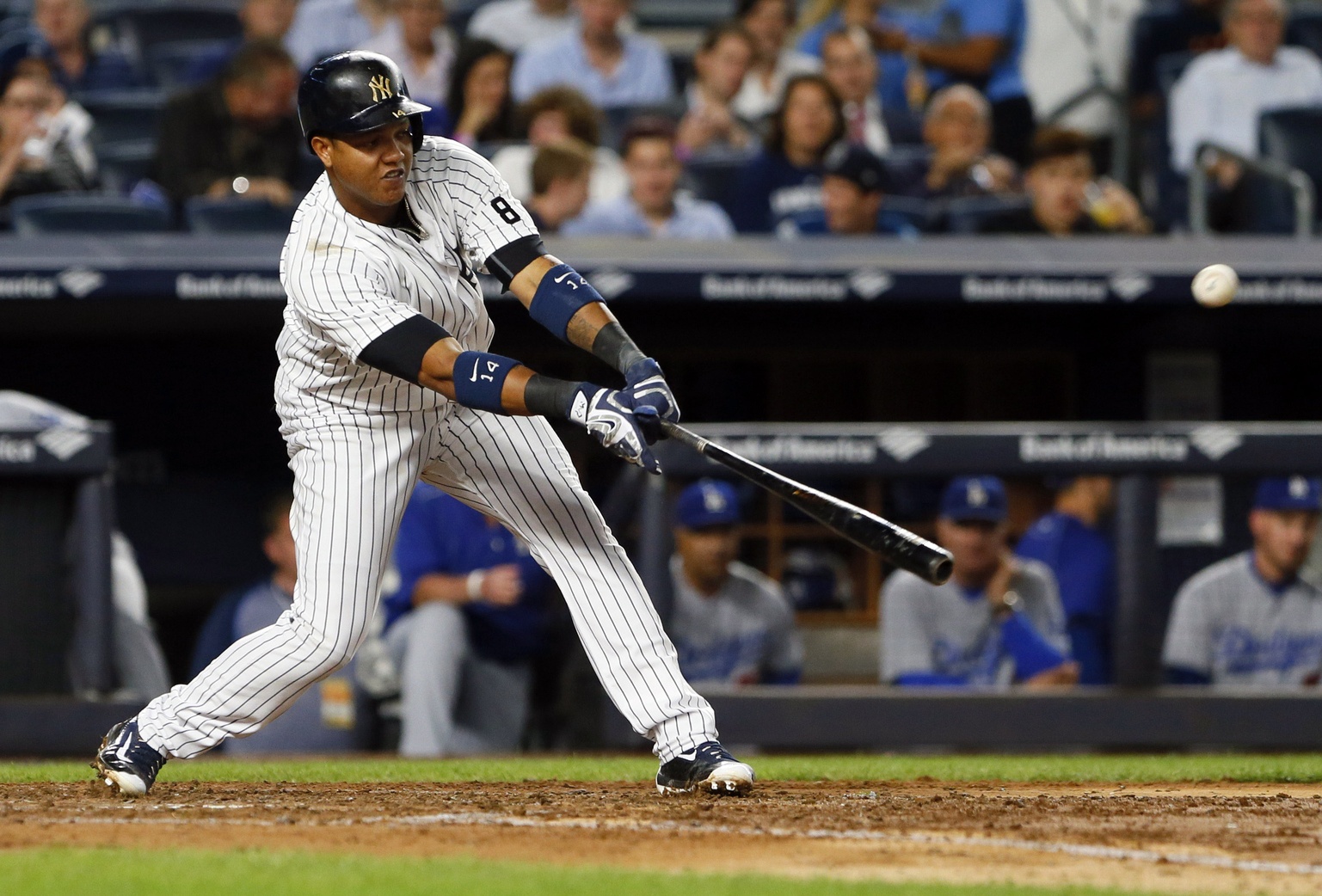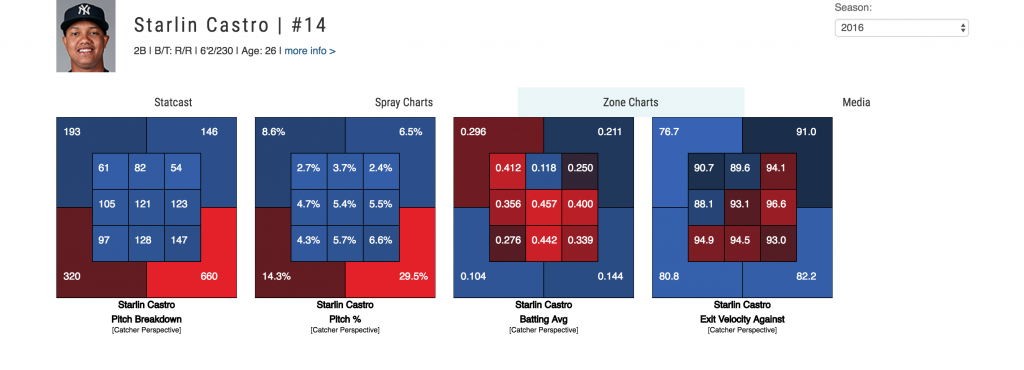The youth movement has garnered most of the attention in the Bronx these days, and for good reason. The rise of El Gary and the acquisition of Clint Frazier and Co. has created a buzz in the Bronx that has not existed since the mid-to-late 1990s. Consequently, other Yankees such as Starlin Castro have fallen out of the spotlight. Castro, however, is still only 26-years-old and does not turn 27 until March 2017. Since he has already completed seven full major-league seasons, it feels as though Castro should be north of 30. But that is not the case, which makes Castro both an intriguing and potentially integral part of the Yankees youth movement.
Castro has shown flashes of dominance throughout his career, but he has yet to fully blossom into the star he was once projected to be. Does that mean he will never be that star? Or is there still time to develop?
Critics of Castro will claim that he has had an ample amount of time in the majors to make adjustments and has failed to do so. Now, I am not here to defend Castro. He has continuously failed to adapt. But should he be punished for making his big-league debut at 20? Even though he’s been in the league for seven seasons, he is still only 26 and technically has not reached his “peak years.” There still is more than enough time for Castro to adjust and develop as a hitter. But will he?
In his first season in the Bronx, Castro slashed .270/.300/.433 with a career high 21 HRs, the eighth-most among American League second basemen. While those appear to be respectable numbers, Castro’s measly .300 OBA is unacceptable. His OBP ranked 19th among 21 qualified players at his position, only better than Jonathan Schoop and Rougned Odor. Additionally, Castro’s .300 OBP ranked 133rd out of 146 qualified hitters last season. Simply put, Castro’s OBP was abysmal.
Castro’s .300 mark in 2016 was only the third lowest OBP he has ever recorded in a season. Castro has managed to record both a .284 OBP and a .296 OBP in 2013 and 2015, respectively. In other words, Castro has zero plate discipline. Zero. He will swing at anything and everything. With 24 walks last season, Castro ranked 136th out of the 146 qualified hitters. He was also only one of six qualified hitters to have a walk rate below four. Here is an example of Castro’s lack of plate discipline:
To further put Castro’s free-swinging nature into perspective, the most walks he has ever taken in a single season is 36. He has 210 career walks in seven seasons (4,374 plate appearances). That averages out to exactly 30 a season. In 2015, Joey Votto—the king of plate discipline—walked 38 times in a single month. I’m not suggesting that Castro should or could develop similar plate discipline skills to Votto, but if Castro wants to be a part of the Yankees future plans he needs to learn, adjust, and develop.
Castro’s O-Swing%—otherwise known as chase rate—was 36.4% in 2016, the 19th highest among qualified hitters. If there is one thing Castro has succeeded at, it is that he has consistently chased pitches outside of the strike zone throughout his career. Since 2002 (the earliest that chase rate data was recorded), Castro’s 33.8% O-Swing% ranks 93rd out of the 778 qualified hitters. Even Chris Davis has a lower career chase rate than Castro.
Let’s take a closer look at Castro’s batting chart to further understand his struggles with pitches outside of the strike zone (from baseballsavant).
Look, there is only one Vlad Guerrero. Castro cannot afford to continue to chase pitches at an abnormally high-rate. Of all the pitches Castro saw in 2016, 58.9% of them were outside the strike zone, with an astonishing 29.5% of those pitches located down and in. In other words, teams and pitchers are well aware of Castro’s free-swinging nature and are exploiting it. It should be noted that Castro had decent success with pitches up and out of the zone, batting above .200 on pitches located within those areas. However, his problem lies down and outside of the strike zone. He managed to hit only .104 on pitches located down and away and .144 on pitches located down and in. Those two areas accounted for 43.8% of the pitches Castro saw in 2016.
If Castro keeps swinging, there is zero reason that pitchers will not continue to take advantage of his lack of plate discipline. However, it is possible for Castro to adjust. And it does not have to be overnight. It is a gradual process. Castro needs to focus on improving his plate discipline this offseason. He needs to learn how to layoff pitches outside of the strike zone. If he does, Castro has the ability to develop into an exceptional hitter and establish himself as an essential piece of the Yankees’ youth movement. If he continues to neglect the problem, then it is entirely possible that the Yankees will quickly become irritated with his lack of discipline and happily cut ties with him when his contract is up in 2020. It is up to Castro. Whether he takes the time and is patient enough to improve his plate discipline remains to be seen. The Yankees and their fans certainly hope he does.
Photo: Noah K. Murray/USA Today Sports


Except he clearly did NOT swing and did catch it in time. Horrible call.
But his batting eye DOES suck……..
PS – He’s got exactly one season (maybe) left to develop that eye. Then Torres is likely in town and either he or Didi moving to 2nd.
There are players who just don’t mature as quickly as coaches and Brass think they should. Castro could very well be one. Without doubt, he has to learn to be far more selective at the plate. Not an easy lesson to learn under any circumstances. He’s also learning a new position, and for a new team under the hottest of all spotlights, in New York City’s Yankee Stadium. Personally, I think Castro appears to be a late bloomer. Partly, as the article points out, because he came up at such a young age. I like the guy. It seems as if, and this is strictly my observation, what I think I see in Castro, is that the game is finally slowing down for him. I like that he’s developing more power. If the game slows for him more this season, his power numbers improve, he is more selective at the plate, then we’ll know it was a good trade. Maturity comes early for many baseball stars. For others, not so. Castro could very well be the latter. I predict an increase in power for the future, and I think we’ll see continued growth in his overall game. The sooner he learns to take a pitch off the outer edge, the sooner he’ll develop more power. If he can hit 25+ homers swinging at everything, think of what he could achieve thru swinging at the pitch he’s actually sitting on, by putting himself in more hitter’s counts.